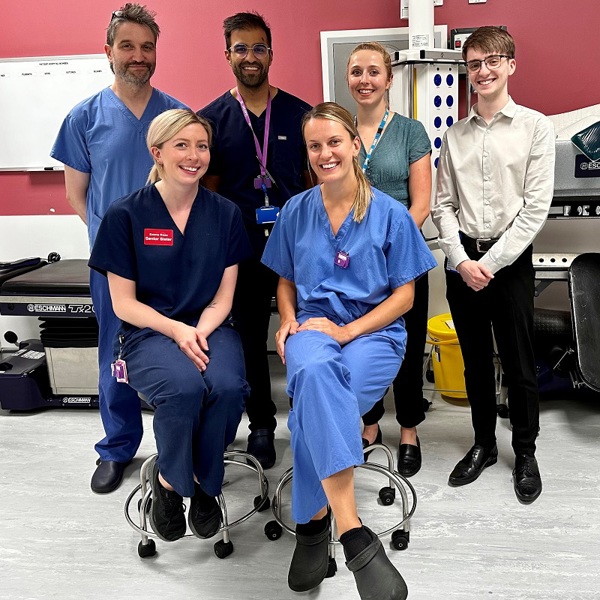Press release posted August 2023
The Christie NHS Foundation Trust in Manchester is pioneering a procedure to treat liver cancer through the wrist.
Developed by interventional radiologists during the pandemic to avoid overnight hospital stays, the innovative technique is based on a similar technique used by cardiologists to restore blood flow for heart patients.
The complex procedure, called SIRT (selective internal radiation therapy), involves injecting radioactive particles into the liver arteries through a catheter (plastic tube) under local anaesthetic. The radiologist is guided to the patient’s liver arteries via ultrasound and X-rays.
The current standard treatment involves the SIRT particles and catheter entering the body via the groin (femoral artery). When the procedure enters via the wrist (radial artery), the patient is required to lie flat for the duration of the 2-hour procedure but is then free to leave, in contrast with the groin where the patient is required to lie still for a further 6 hours. In addition, performing the procedure via the wrist has demonstrated a much greater safety profile in comparison with the groin.

Dr Pavan Najran, consultant interventional radiologist at The Christie, who has developed the new technique along with national and international colleagues, said: “Using the radial artery to administer radiotherapy is such an innovation that specific devices to perform the procedure have not been developed fully. We have had to adapt the equipment available to us. We want to make this available for all patients with liver cancer requiring SIRT.
“This approach is beneficial for patients as it has a much lower risk, and it also means we can treat more patients, particularly those who would be unable lie flat for a considerable amount of time. It also reduces a 2-day visit, involving an overnight stay, to just 1 day.
“The Christie is a leader in delivering liver radiotherapy through the wrist. We were the one of the first institutions in the UK to attempt the procedure, and remain the leading centre, treating the largest number of patients this way. This is a game-changing technique, and we are now looking to see if we can support the development of radial procedures, opening other specialities to use it more widely including treating patients who have had a stroke.”
Heather Norgrove (75), from Coventry, who was a hospital manager for 40 years, holding senior positions in the Midlands, has experienced both radiotherapy through the groin and the wrist to treat her liver cancer. Comparing the two, Heather said: “When I was asked if I’d like to take part in the trial and have the radiotherapy through my wrist, I was happy to try it. When they go through the groin you have to lie still for six hours afterwards which can be uncomfortable. When done via the wrist you are free to get up and go. It’s a little more painful but you know it only lasts a couple of hours so, on balance, it’s worth it for the relative freedom it brings. You can walk around the ward and eat between procedures. My hand went numb and I had pins and needles but that quickly passed.”
The grandmother of 2 has had cancer 3 times. She was diagnosed with Hodgkin’s lymphoma when she was 18 and then 2 weeks after she retired in 2013 found a lump on her arm which was stage 3 melanoma. She was almost signed off by her consultant when in 2018 a blood test picked up a tumour in her liver. She was referred to The Christie in May this year and has so far had 3 radiotherapy sessions.
Talking about her experience as a patient at The Christie, Heather said: “The Christie is such a positive place where all the staff smile and have a laugh and a joke with you. The atmosphere is fantastic and you feel carefully nurtured. The attitude is just lovely to see. We really don’t mind our trip up the M6, and we get to see our youngest granddaughter who is at university there which is a bonus.”
The RAD observational study, led by Dr Pavan Najran from the interventional radiology team at The Christie, measures the radial artery during the procedure in a range of patients to determine whether the wrist can be used for a range on interventional procedures. The study also enables radiologists to better understand delivery of liver radiotherapy through the wrist and develop better guidance to be used globally.
This study is sponsored by The Christie NHS Foundation Trust and supported by a scientific grant from Terumo.
Any patients interested in taking part in clinical trials should discuss this option with their consultant or GP. Not all patients will fit the criteria for a specific trial. While clinical trials can be successful for some patients, outcomes can vary from case to case. More information about taking part in clinical trials can be found on our take part in studies and trials page.
